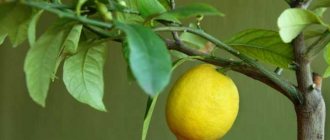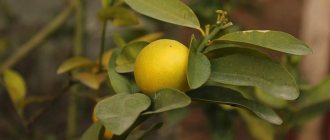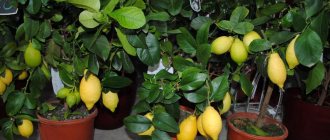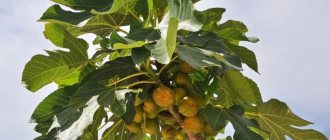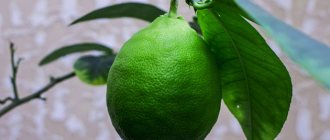Every year, cultivating citrus fruits indoors is becoming an increasingly popular hobby among gardeners. Most often, window sills are decorated with lemons; you can also often see tangerines. However, there are also more exotic representatives of Citrus fruits, for example, calamondin, which is also called citrofortunella.
Calamondin is a hybrid that is the result of crossing a kumquat and a mandarin orange. This plant is excellent for growing indoors, and it gives a good harvest.
Features of calamondin
Under natural conditions, calamondin is grown in Southeast Asia. In nature, the height of a tree can reach about 700 cm. Trees grown indoors have more modest sizes. The maximum height of indoor citrofortunella is 120 centimeters.
The branches are decorated with oval leaf plates with a glossy surface. Flowering is observed in spring and summer. At this time, small white star-shaped flowers are formed on the tree, which have a pleasant aroma.
If you care for such a citrus plant correctly and provide it with favorable conditions for growth, then the formation of fruits will be observed all year round. Externally, calamondin fruits are similar to tangerines, but they are smaller in size: on average they weigh from 10 to 15 grams. They also have a special bitter-sour taste.
Calamondin. The fruits are ripe
General description of the calamondin plant
Citrofortunella microcarpa or citrus calamondin micro is the name of a self-pollinating crop that is a hybrid of a kumquat and a tangerine tree. This compact tree is distinguished by leaves of a rich green hue, they exude a pleasant aroma. It blooms with white buds that have a good smell. This plant is also called indoor tangerine.
The bush is distinguished by small fruits that visually resemble small tangerines.
The berries have an orange peel and are very aromatic.
In its natural environment, this tree can reach up to 7 meters in height, but at home this figure does not exceed 150 centimeters. The root system of the bush is very well developed, the roots tightly entwine an earthen lump formed in a container. The stems and roots have pale brown bark.
Indoor mandarin calamondin bears fruit well in indoor conditions, since the flowers are self-pollinating. To increase the likelihood of fruit formation, you can additionally pollinate the bush using a brush. After 1-1.5 months, orange fruits are formed on the bush, visually reminiscent of tangerines. Calamondin can be eaten; the berries of the tree are eaten together with the peel. The fruits have specific taste qualities - the sour pulp goes well with the sweet skin.
Due to the fact that calamondin is a standard plant, it is actively used to decorate rooms.
You can learn more about growing plants in pots in our article “Container Gardening”
What to do after purchase?
If you purchase grown citrofortunella in a specialized store, then you need to remember that it is grown using a special technology for sale. As a rule, when placed in indoor conditions, a tree needs some time to adapt. In addition, plants that already bear fruit are often put up for sale.
In order for the citrus to grow and develop further after fruiting, it must be provided with optimal conditions so that it can successfully get used to the new place. If you neglect this advice, the bush may die.
Creating comfortable conditions:
- you need to create a mini-greenhouse for the plant: to do this, cover it on top with a plastic bag;
- systematic ventilation is required (twice a day);
- watering should be such that the substrate in the pot does not dry out;
- for the bush you should choose a place protected from direct sunlight;
- When purchasing a tree in winter, it is provided with additional lighting.
It is very simple to understand that the plant has fully adapted to new conditions. New foliage will begin to form on the bush. As a rule, the adaptation period for citrus takes about 15 days.
Adaptation of citrus fruits after receipt
Errors in care
If calamondin leaves dry out and turn yellow, the cause may be low humidity, insufficient watering, or too bright direct light. Rotting parts of the plant indicate excess soil moisture, especially in the cold season. If there is a lack of fertilizer, fruits may drop. Citrus stops blooming if there is no dormancy in winter, low light, lack of nutrition and pest infestation. When a plant sheds its leaves and its branches dry out, the reason is a draft, watering with cold water or stress during transplantation and adaptation.
Caring for calamondin at home
In order for calamondin to bloom regularly and bear fruit at home, you should adhere to the temperature regime recommended by a specialist, as well as provide it with proper lighting and regular moderate moisture of the soil mixture in the pot.
Choosing a pot
This citrus is a spectacular tree with a developed root system. This should definitely be taken into account when choosing a container for planting it. The earthen ball of the tree should be one and a half times smaller than the diameter of the selected pot. For the normal development of such a plant, it needs space.
Lighting
For indoor calamondin, it is better to choose a window sill with an eastern or southern orientation. In this case, it is necessary to protect the foliage from direct sunlight, otherwise they may leave burns on the bush. Moreover, the eastern window is best suited for such a light-loving culture. If you decide to place it on a southern window sill, then you can apply a protective film to the window that does not allow direct rays of the sun to pass through.
In the warm season, if possible, the bush can be moved to the balcony. At the same time, a place is chosen for it so that the lighting is diffused throughout the day. In the winter months, Citrofortunella must be provided with additional lighting. In this case, the optimal duration of daylight hours is about 12 hours. Experts recommend using a phytolamp for illumination.
To make it easier to provide the plant with the correct lighting conditions, it is recommended to purchase a decorative flower cart. Thanks to it, you can change the position of the bush without touching the pot itself.
Substrate
The soil mixture should be fertile and light. You can purchase a soil mixture for citrus fruits at a specialized store, or if you wish, you can make it yourself. To do this, you need to combine sand, turf soil and manure (1:2:1).
There must be holes for drainage at the bottom of the container. Also, do not forget to lay out a good drainage layer 30–40 mm thick; expanded clay is perfect for this.
Temperature
During the growing season, which is observed in spring and summer, citrofortunella should be kept warm: the optimal air temperature is 24–28 degrees. During wintering, the plant is moved to a cooler place (from 15 to 18 degrees).
Air humidity
Citrus needs high air humidity, its level should not fall below 70 percent. To increase humidity, the bush is regularly moistened with a spray bottle, and an open container filled with water should be placed next to it. It is recommended to moisten the foliage regularly, two or three times a day. If you neglect this rule, then no fruit will form on the bush.
Watering
Calamondin should be provided with such a frequency of watering that the top layer of the substrate is always slightly damp. Some time after watering, be sure to check the pan. If there is water in it, then it must be poured out.
In autumn and winter, the air in the room is dried out by operating heating devices. Therefore, at this time, it is recommended to pay special attention to increasing the level of air humidity, while the soil mixture in the pot should be moistened less frequently and less abundantly.
Fertilizer
From the beginning of spring, they begin to regularly feed calamondin. They are carried out three or four times a month, using liquid fertilizers. Complex mineral fertilizers for flowering or citrus plants are excellent for such a crop.
Also, such a compact citrus tree responds well to foliar feeding; for this, the nutrient mixture is applied to the foliage using a spray bottle. In winter, fertilizers are added to the soil mixture once a month.
Bloom
The beginning of flowering of such a plant occurs in May, and fragrant flowers adorn the bush until July. The small star-shaped white flowers look very impressive against the dark green foliage. An interesting fact is that both flowers and ripening fruits can be present on a tree at the same time.
With proper care, the plant will definitely delight you with unusual fruits that look like very small tangerines. The average weight of the fruit is from 10 to 12 g. The duration of fruit ripening is from three to four months.
Is it possible to eat citrofortunella fruits? Yes, the fruits are edible. Those who have tried them advise eating the fruit without peeling it. In this case, it will not seem so unbearably sour. Each fruit contains a large number of seeds, which are seeds.
Rest period
After the fruits ripen, they need to be collected. After this, the plant begins a dormant period. In November, the tree should be moved to a place where the air temperature does not rise above 12–15 degrees. Also, the place should be well lit, and additional lighting can be used.
At rest, the plant does not need a lot of moisture, so it is watered 1 or 2 times a month. The beginning of the new growing season occurs in the first days of March.
Trimming
In most cases, gardeners use pruning to give the calamondin crown a spherical shape. The plant is pruned in the last days of February, just before the beginning of the growing season.
However, the tree not only needs formative pruning, it also needs regular sanitary pruning. To do this, remove injured and dried branches. In order for the bush to be more lush, in the summer the upper parts of all its shoots are pinched.
Care depending on the time of year
The rules for caring for indoor calamondin directly depend on the time of year. For example, in the spring-summer period the plant needs regular fertilization and pruning, in the autumn months the fruits are collected, and in the winter the bush is provided with optimal conditions for dormancy.
Experienced gardeners recommend creating a schedule for caring for this citrus fruit. Then you definitely won’t forget anything, and the plant will delight you with its appearance and fruits.
Calamondin or citrofortunella - homemade tangerine: winter care features
Transplanting calamondin
Calamondin is transplanted only:
- in the process of reproduction;
- after purchasing in a store;
- when the bush becomes crowded.
If a citrus tree recently purchased in a store has tolerated the adaptation period well, then it is time to transplant it into a permanent pot.
Planned transplant
Until the tree is 3 years old, it needs regular annual replanting. More mature bushes are subjected to this procedure less often, or rather, once every couple of years. Such transplants are planned.
Before you begin to directly transplant the plant, you need to find its root collar and remember where it is. The fact is that after transferring calamondin to a new container, its root collar should be in the same position relative to the surface of the substrate. The transplanted bush requires mandatory watering.
After the purchase
It is recommended to replant a plant purchased in a specialized store into a new container. However, this is done 15–20 days after purchase, during which time the tree must adapt to new conditions. Step-by-step transplant instructions:
- In order for the bush to be easily removed from the store pot, it should first be watered generously. Leave the substrate to soak for several hours.
- Carefully remove the bush from the old container, while holding it by the trunk.
- A drainage layer is made at the bottom of the new container, after which the plant is installed in it.
- Hold the barrel with your hand so that it is in a vertical position. The substrate is gradually poured into the pot and carefully compacted so that there are no voids left.
- The plant needs to be watered.
- The transplanted plant is fed for the first time after 6 weeks.
Remember that during the transplantation process it is strictly prohibited to wash the root system of citrofortunella. The fact is that this can lead to the death of the bush.
Transplanting citrus fruits in apartment conditions
Calamondin
The plant is native to Asia. In natural conditions, calamondin is a citrus, which is larger in size and is a shrub 5-6 meters high.
Citrofortunella fruits are rich in vitamins
Calamondin was obtained by crossing a mandarin orange and a fortuneella (kumquat). The second name of the plant is citrofortunella. It appeared as a combination of two words - citrus and fortunella. We can say that calamondin is a micro citrus.
Description
The appearance of this plant can be characterized by three main parameters: leaves, flowers and fruits.
| Leaves | Dark green round shape. They have a dense structure and are quite large. Thanks to the accumulation of essential oils in the plate, they exude a pleasant citrus aroma. |
| Flowers | The flowering period occurs in the spring. The flowers are small, white or milky beige, collected in inflorescences. The smell is pleasant, with citrus notes. |
| Fruit | They are very similar in appearance to tangerines, but smaller in size. The taste is sweet and sour, pronounced citrus. The fruits have a lot of seeds. With proper care, fruiting is abundant and long-lasting. |
The size of the bush depends on the variety and growing conditions.
Given free space and comfortable conditions, calamondin can reach a height of 2-3 meters. Such a large specimen, as a rule, can only be grown in greenhouse conditions. Despite the low taste of the fruits, they are no less useful than other citrus fruits. They are rich in vitamin C and vitamins.
Obtaining fruits
As a rule, flower shops sell calamondins with fruits already hanging on their branches. When purchasing such a plant, remember that its fruits are most likely not ripe. In addition, you should take into account the fact that when you bring the tree home, its fruits may fall off.
If you purchased a young bush that does not yet bear fruit, then it is quite easy to make it bear fruit. The most important thing is to provide the bush with the most favorable conditions for growth. Do not forget to timely apply fertilizers to the substrate, provide high air humidity and a dormant period, and then this unusual citrus plant will delight you with its fruits.
After the fruits have ripened well, they are carefully trimmed and, if necessary, stored in a place where it is always cool. In order for the plant to bear fruit annually, you need to monitor the condition of its crown. Those stems and branches that have not produced fruit for the second year in a row must be cut off.
CALAMONDIN CARE at home./FLOWERING and the beginning of FRUITING!/Homemade Mandarin
Transfer
Kalamandin requires two types of transplantation - planned and after purchasing the plant in a store. For each case there are certain nuances and rules.
Planned transplant
Tangerine tree - care at home
For young specimens, the soil and pot are replaced every spring; for older specimens, it is enough to carry out this procedure once every 2-3 years. Step by step it looks like this:
- The day before transplantation, water the plant abundantly.
- Kalamandin is removed from the old pot by gently pulling it by the trunk.
- Drainage is poured into the bottom of the new container with a 2-3 cm layer of crushed stone, expanded clay or broken brick.
- The root system with a lump of earth is placed in the center of the pot.
- The voids are filled with soil, leaving a small distance from the top edge of the container.
- Watering is carried out and soil is added.
Attention! Citrofortunella roots are very fragile. You need to move the plant from one pot to another very carefully so as not to break them. Mechanical damage to the roots can lead to disease and even death of the plant.
Replanting after purchase
After purchasing calamandin in the store, you should not immediately start replanting. This plant is very sensitive to changes in growing conditions; it requires 10-14 days to acclimatize. During this period, it is better to leave the bush alone and cover it with a plastic bag.
14 days must pass from purchase to transplantation
Don't worry if the plant drops some of its leaves. This is a natural process after a change in conditions of detention. When the acclimatization period passes, the vegetative mass of the crown will return to normal.
Reproduction methods
The lifespan of citrofortunella growing in natural conditions is about 100 years. At the same time, the indoor tree has a shorter lifespan. In order to preserve the plant, you need to learn how to propagate it correctly.
Cuttings
It is recommended to take cuttings in the last weeks of spring, shortly before the bush blooms. The branches that are located in the upper part of the crown are suitable for this. Each cutting should have two or three buds.
The piece must be immersed for some time in a solution of a root growth stimulating agent (for example, Kornevin). For rooting, it is planted in a pot filled with substrate, and covered with a glass jar on top.
Move the cutting to a well-lit place and provide it with regular ventilation, which is carried out twice a day. The roots on the segment should appear after 20–30 days. After this, the bush can be transplanted into a permanent container. Flowers and fruits will appear on it only in the second year of growth.
Rooting calamondin fruit branches
Growing from seeds
Propagation of calamondin by seeds is quite popular among gardeners. It should be remembered that the seeds of such a plant are also called seeds.
For sowing, seeds are selected from well-ripened fruits. Since their germination rate is low, you will need a relatively large number of seeds.
Collect seeds in autumn. Remove all the pulp from them, dry them well and store until spring. Sowing is carried out in March, immediately before it the seeds are immersed in a solution of a growth stimulating agent for two or three days.
Sow the seeds in a box filled with substrate to a depth of 15–20 mm. Cover the top of the crops with glass or film and put them in a dark and warm (about 28 degrees) place. Air them twice a day.
The first seedlings should appear after about 4 weeks. At this time, the crops are transferred to a well-lit place. The shelter is removed after 7 days. After 3 or 4 leaves grow on the plants, they are picked into individual containers.
Reproduction of Calamondin./The seeds have sprouted inside the fruit!!)/My experiment!
Graft
If you are an experienced gardener, then you can try to propagate citrofortunella by grafting. Young seedlings are suitable as a rootstock, and the scion is taken from an adult healthy tree.
Select a strong and healthy branch and cut it off. The length of the scion should be about 10 cm. An incision must be made on the bark of the rootstock. Next, the edges of the bark are moved apart and the scion is inserted diagonally. For fixation use adhesive tape. The top of the bush should be covered with film. The graft will take root within 30 days. After a couple of months, you can remove the fixing tape.
Plant propagation
There are several ways to grow a plant: from the ripened fruit, seeds are planted in the soil, using cuttings and a scion of shoots.
It is very difficult to grow a young seedling using any of these methods. It takes a lot of time and patience. But, nevertheless, many gardeners grow.
To grow Calamondin, ripe fruits are selected from the seeds. The seeds are separated and planted in a soil mixture of turf and sand. The process of sprouting is very long. To speed it up, they use growth agents and water the soil with solutions. Also cover the top of the container with the seeds with glass or film.
To grow a tree using calamondin cuttings, a number of conditions must be met.
How to root a calamondin cutting:
- The cuttings are cut only from the shoot that has large leaf nodes. Cut off the top, length up to 15 cm.
- Soak for a minute in any growth stimulator. For example, Epin or Kornevin.
- The cuttings are deepened into a moist soil mixture of turf and sand to the lower leaves.
- High humidity is required for roots to begin to form. Therefore, the container with the cutting is covered with a glass jar or plastic bag.
- Every day you need to ventilate the cuttings and, when dry, water them with warm, settled water.
After 4-5 weeks, roots will begin to grow. Then the seedlings are transplanted into other containers using the transshipment method.
Diseases and pests
Most often, domestic calamondin suffers from diseases such as:
- Sooty fungus . A black coating appears on the surface of the foliage. Remove it with a napkin. To cure a bush, it should be treated with Fitosporin. It is also used to disinfect the substrate in a pot.
- Gommoz . The affected tree's foliage and other parts turn yellow en masse. Initially, the lower leaf plates begin to turn yellow, after which the disease spreads to the entire plant. When the first symptoms of the disease appear, cut off the affected stems and coat the cut areas with copper sulfate.
- Anthracnose . Initially, yellow spots appear on the foliage of a diseased bush; after some time, other parts of the plant begin to die. This leads to his death. The bush can be cured only at the early stage of the disease. To do this, use a solution of copper sulfate (3%).
Pests such as scale insects, aphids and mealybugs can settle on citrofortunella. To destroy them, use an insecticidal solution.
Content Rules
Lighting
To place calamondin, as a sun-loving plant, you should choose windows facing southeast or southwest. However, it should still be protected from the scorching summer midday rays.
Calamondin requires special care, starting on the eve of winter. Even in the fall, when the amount of lighting gradually decreases and the temperature remains the same, the plant at home begins to suffer. In the winter months, the ideal conditions for citrofortunella are low temperatures and additional lighting. Even the sunniest window will not be enough. Daylight hours for this plant should last 12 hours.
Air temperature
It is advisable to keep it in summer at a temperature of 18–26 degrees. Winter temperatures should be maintained within 15 degrees Celsius. Citrofortunella will not tolerate sub-zero temperatures. If the calamondin does not receive appropriate care in the winter, then, unfortunately, it will not be destined to please its owner for a long time. In just three years he could die.
There is also a specificity in maintaining the same temperature at different altitudes. That is, the air in the crown area should be the same temperature as in the rhizome area. For us, perhaps, the difference is not even perceptible, but the plant will not feel good from the changes.
It is advisable to place the pot with citrufortunella on a slight elevation, since the temperature of a regular floor is often slightly lower than that of the ceiling.
Under such conditions, the plant will not be able to absorb enough moisture from the soil. You should not place the pot on the very bottom, even if the “warm floor” system is turned on. In this case, calamondin, on the contrary, runs the risk of becoming oversaturated with excess moisture. Such incorrect care can lead to dropsy.
Soil requirements
For citrus plants, soil with weak or neutral acidity is suitable. A good option for calamondin is the purchased ready-made “Lemon” substrate.
Watering mode
The process, both in summer and winter, should be focused on the condition of the soil. It should always be kept moist, but the top layer should have time to dry between waterings.
The citrus plant needs fairly high air humidity. The room where it lives needs to maintain humidity at about 70 percent.
Fertilizing
Fertilizing should only occur during the growing season. In the autumn, and especially in the winter months, fertilizers should not be applied. Before applying fertilizer, the soil must first be moistened.
It is better to choose fertilizers special for citrus fruits
It is important not to overdo the dosage so as not to burn the root system. The manufacturer's dosage recommendations should be strictly followed, and before entering the rest period, first reduce the concentration by half
Transfer
For calamondin, transplantation is a very dangerous procedure. During this process, there is a risk of damage to the very sensitive symbiotic fungus, which performs the function of nutrient absorption for the roots of the citrus fruit.
Diseases and pests
Citrus fruits can suffer at home primarily due to a lack or excess of lighting. In the first case, the sign will be large leaves of a rich green color, or yellow, falling leaves; in the second, the leaves will be light, discolored.
Possible problems
If calamondin is not properly cared for, problems may arise such as:
- Drying of branches and flying leaves . If the leaves fly away in autumn, then this is a completely natural process. If leaf shedding is observed at other times, this may be due to improper watering, poor lighting, or a violation of the temperature regime.
- Unripe fruits fly around . This happens when the earthen clod is dry or there is an acute lack of nutrients. In addition, the bush can drop fruits on its own if there are a lot of them.
- Lack of flowering . Too poor lighting. Move the bush to a suitable place or provide additional lighting. In some cases, the cause is a lack of moisture and nutrients.
Care problems
Improper care of calamondin at home can cause a number of problems. The plant becomes weaker, more capricious, and more sensitive to damage by fungi and insects. If they are identified in time and mistakes are corrected, the plant can be easily saved. Problems that arise if you do not care for the plant correctly:
- Calamondin drops all its leaves. There are several reasons for this phenomenon: high temperature in the room, draft, overflow, use of cold water for irrigation. Sometimes leaf fall begins when the tree is moved to a new location; adaptation lasts up to 2 months. To solve the problem, regulate watering, temperature and humidity in the room. If ineffective, the bush is replanted.
- Calamondin leaves turn yellow and fall off. This phenomenon occurs when there is a lack of magnesium in the soil. To prevent the bush from dropping its leaves, apply fertilizer.
- Calamondin does not bloom. Citrofortunella stops blooming if the soil lacks nutrients, in poor lighting, inappropriate soil, in a cramped pot, or with frequent changes of location. Flowering stops if the bush is sick or is attacked by pests.
- The fruits are falling. The reason is a lack of nutrients. During the period when Citrofortunella bears fruit, it must be fed.
- The leaves first drooped, then curled and dried. A sign of underfilling, high temperature and dry air in the room.
Proper cultivation and compliance with all care rules prevents all of the problems listed above. If necessary, the bush should be replanted after inspecting whether the roots have rotted. If correcting errors does not bring results, most likely the tree has a more serious pathology or has been attacked by pests.
Superstitions and signs
It is believed that calamondin improves the emotional environment in the home. If you place a bush in the north-eastern part of the room, it will be able to attract wealth into it.
To ensure a successful business meeting or important event, before going there, take a leaf and rub it between your fingers. If you place a tree in the bedroom, it will help strengthen feelings between spouses, while family life will be cloudless and long.
ALL ABOUT GROWING CITRUS FRUITS AT HOME
Calamondin dormant period
Calamondin is one of those plants that needs properly organized wintering.
The dormant (wintering) period should begin in November and last until February. In order for this period to be successful, it is necessary to provide the calamondin with full daylight hours and a cool temperature - no higher than +12°C. At this time, the number and frequency of watering is also reduced, which after a month should be carried out 1-2 times every 4 weeks. The plant “wakes up” in March, after which its growth and vegetation intensify.
Important! In order for the plant to “wake up” faster, it is necessary to gradually increase the temperature in the room by several degrees.
Calamondin flowering
There are many varieties of calamondin that can be successfully grown indoors. The main difference between them is the appearance and taste of the fruit. Flowers can differ only in the shades of the petals - from white to cream.
There are a few particularly noteworthy species.
- Margarita Nagami. The fruits are more like orange in color and lemon in taste.
- Margarita Big. The pear-shaped fruit is a distinctive feature of this variety.
- Maeva. The advantage is the sweet taste of the fruit and the absence of seeds.
- Tiger. A special feature of the variety is the unusual color of the leaves - they have a golden rim along the edge.
- Centenial. During fruiting, unusual fruits appear on the bush, resembling watermelons in appearance.
Picture 5 The Senteniel variety amazes with the appearance of its fruits
There are many other varieties, each of which has its own advantages. For example, for those who love flowering calamandin, the Peters variety is a good choice. It blooms profusely and beautifully, but its fruits cannot be called tasty.
Transplanting calamondin
It is best to replant citrofortunella into a large pot, since, despite the small tree, calamondin has a large and branched root system.
The following mixture is used as planting soil (2 parts turf soil + 1 part rotted manure + 1 part sand). The plant is not fertilized for a month, since this planting mixture contains a sufficient amount of nutrients.
When replanting, you should preserve the earthen ball and do not destroy it. It is also necessary to provide drainage in the pot. The planting depth and root collar in the new container should be at the same level.
Calamondin propagation by cuttings
The reproduction process is long and complex. It will take many years to grow calamondin from seeds and get the first fruits.
Planting material from cuttings is rooted in a loose substrate in greenhouse conditions with mandatory lower heating. The optimal temperature for the appearance of roots is +23 + 25 ᵒC, therefore it is preferable to carry out plant cuttings at the beginning of summer, when the air is warmed up to the required temperature and there is sufficient daylight hours. Even if these conditions are met, not all cuttings take root. At this stage, the use of phytohormones is recommended.
Adaptation and transplantation
After purchasing calamondin, it should be replanted. Stores often use cramped pots with a small amount of peat soil. In it, the citrus will dry out and overheat. You should choose a larger pot with drainage holes at the bottom. First, lay out coarse material for drainage, and then pour in soil. The soil should include:
- turf land;
- leaf humus;
- rotted manure;
- river sand.
You can buy a ready-made mixture for citrus fruits. Transplantation is done by transferring an earthen clod. After the procedure, calamondin should be moved to a shaded place for several days and watered moderately.
Sometimes after the first transplant, calamondin begins to actively shed its leaves. Even if only bare branches remain, you can try to save the tree. All fruits and some shoots should be trimmed. The cut areas are dipped in crushed activated carbon. The plant continues to be kept in a bright room. It is necessary to spray the shoots daily with any medicinal solution.
The soil is moistened very carefully. After a few weeks, young shoots can be found on the branches.



